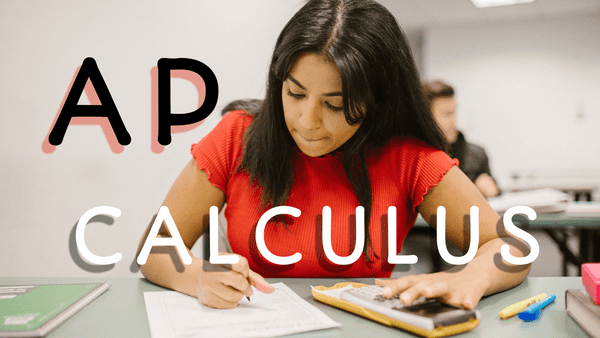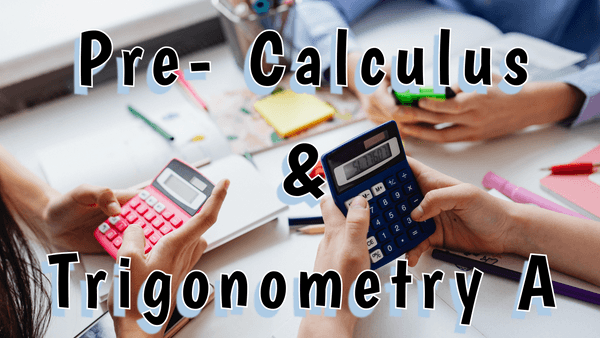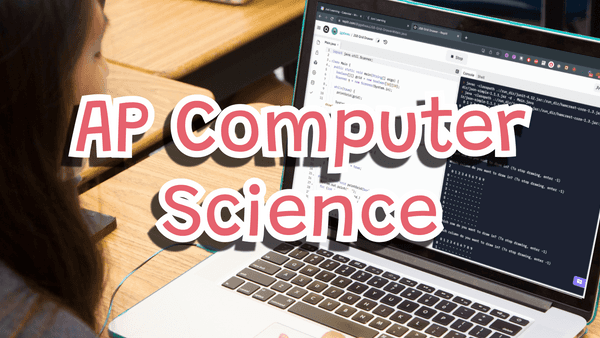AP Calculus
AP Calculus is renowned as one of the most rigorous math classes that high school students can take. Game on! This course prepares students for the AP Calculus AB or BC exams, which show colleges the academic rigor students welcome and how prepared they are for more advanced undergraduate courses.

- Private 1:1
- Format
- Age 15-18
- Learners
- Weekly
- Classes
- 50 minutes
- Per class

About this Course
Billing
Billed as
$275 / month
Scheduling
1:1 classes are 50 minutes long and can be scheduled anytime Monday-Sunday from 7am to 7pm PT. To begin, select Book your Placement Class to signup. Our team will then match you and set up your first class!
- Course duration4-6 months
- Lesson50 minutes
Learning Targets
Introduction to Limits
Limits-1: The student can estimate the rate of change at an instant using average rates of change over intervals containing that instant.
Limits-2: The student can interpret/represent limits in analytic notation.
Limits-3: The student can estimate limits from graphs and tables.
Calculating Limits
CL-1: The student can determine the limits of functions using limit theorems.
CL-2: The student can determine the limits of functions by using equivalent expressions for the function or the squeeze theorem.
Continuity
Cont-1: The student understands the definition of continuity and can justify conclusions about continuity at a point.
Cont-2: The student can determine over which intervals a function is continuous.
Cont-3: The student can solve for values to make a discontinuous function continuous
Cont-4: The student understands the Intermediate Value Theorem and can explain the behavior of a function on an interval using the IVT.
Cont-5: The student can use limits involving infinity to characterize the end behavior of a function.
Introduction to Derivatives
Derivs-1: The student can determine the average rate of change of a function over an interval.
Derivs-2: The student can represent the derivative of a function as the limit of a difference quotient.
Derivs-3: The student can determine the equation of a line tangent to a curve at a given point.
Derivs-4: The student can estimate derivatives.
Derivs-5: The student can explain the relationship between differentiability and continuity.
Derivative Rules
DR-1: The student can calculate derivatives of familar functions.
DR-2: The student can calculate derivatives of products/quotients of familiar functions.
Derivatives of Trigonometric and Other Functions
DTOF-1: The student can calculate derivatives of familiar trigonometric functions (and products/quotients of those functions).
DTOF-2: The student can interpret a limit as the definition of the derivative.
Derivatives of Composite, Implicit and Inverse Functions
CIIF-1: The student can apply the chain rule to calculate derivatives of compositions of differentiable functions.
CIIF-2: The student can calculate derivatives of implicitly defined functions.
CIIF-3: The student can calculate derivatives of inverse and inverse trigonometric functions.
CIIF-4: The student can calculate higher-order derivatives of a function.
Contextual Applications of Differentiation
CAD-1: The student can interpret the meaning of the derivative in context.
CAD-2: The student can calculate/interpret rates of change in context.
CAD-3: The student can calculate/interpret related rates in context.
CAD-4: The student can use local linearity to approximate the value on a curve using the equation of a tangent line.
CAD-5: The student can apply L-Hopital's rule to calculate limits of functions that result in indeterminate forms.
Analytical Applications of Differentiation
AAD-1: The student can apply the Mean Value Theorem to justify conclusions about a function over an interval.
AAD-2: The student can use derivatives of a function to justify conclusions about the behavior of that function.
AAD-3: The student can apply the First Derivative Test to determine the local extrema of a function.
AAD-4: The student can apply the Second Derivative Test to determine the concavity/local extrema of a function.
AAD-5: The student can apply the Candidate's Test to determine the absolute extrema of a function over an interval.
A Function and its Derivatives
F&D-1: The student can sketch a graph of a function by analyzing its first and second derivatives.
F&D-2: The student can apply functional analysis to optimization questions to calculate/interpret the minimum/maximum value in context.
F&D-3: The student can determine the critical points of implicit relations.
F&D-4: The student can determine the behavior of an implicitly defined function by using its derivatives.
Accumulation of Change
AC-1: The student can approximate the area under a curve using various Riemann Sums.
AC-2: The student can interpret the limiting case of the Riemann sum as a definite integral.
AC-3: The student can write definite integrals to represent the accumulation of a function over an interval.
AC-4: The student can interpret/apply the Fundamental Theorem of Calculus.
Integrals
Integrals-1: The student can calculate definite integrals using areas and algebraic properties of integrals
Integrals-2: The student can evaluate definite integrals analytically using the Fundamental Theorem of Calculus.
Integrals-3: The student can determine antiderivatives of functions to solve definite/indefinite integrals.
Integrals-4: The student can perform u-substitution or algebraic manipulation to solve definite/indefinite integrals.
Integrals-5 (BC Only): The student can perform integration by parts to solve an integral.
Integrals-6 (BC Only): The student can apply partial fraction decomposition to solve an integral.
Integrals-7 (BC Only): The student can evaluate/interpret improper integrals.
Introduction to Differential Equations
DiffEq-1: The student can model a given relationship using differential equations.
DiffEq-2: The student can verify a solution to a given differential equation.
DiffEq-3: The student can use slope fields to visualize the set of solutions to a given differential equations.
DiffEq-4 (BC Only): The student can use Euler's Method to approximate the value of a function given an initial condition and a differential equation.
Solutions to Differential Equations
SDE-1: The student can apply separation of variables to find general solutions to differential equations.
SDE-2: The student can determine the particular solution of a differential equation given an initial condition.
SDE-3: The student knows how to write/interpret models for exponential growth/decay.
SDE-4: The student can apply their knowledge of exponential models to solve word problems involving exponential growth/decay.
SDE-5 (BC Only): The student knows how to write/interpret models for logistic growth.
SDE-6 (BC Only): The student can apply their knowledge of exponential models to solve word problems involving logistic growth.
Interpreting Context for Definite Integrals
ICDI-1: The student can determine the average value of a function over an interval.
ICDI-2: The student can use definite integrals to determine values for positions and rates of change.
ICDI-3: The student can interpret/write definite integrals to calculate the accumulation or net change of a function over an interval.
ICDI-4: The student can calculate the area between two curves using definite integrals.
Volumes of Solids Using Integrals
Volumes-1: The student can find the volume of a solid using cross sections.
Volumes-2: The student can find the volume of a solid of revolution using the disc method.
Volumes-3: The student can find the volume of a solid of revolution using the washer method.
Volumes-4 (BC Only): The student can find the arc length of a curve over a given interval.
Parametric Equations, Polar Coordinates, and Vector-Valued Functions (BC only)
PPV-1: The student can find the derivative of a set of parametric equations.
PPV-2: The student can find the arc length of a parametrized curve.
PPV-3: The student can find the derivative/integral of a vector-valued function.
PPV-4: The student can interpret and work with vector-valued functions in context.
PPV-5: The student can find the derivative of a function written in polar coordinates.
PPV-6: The student can use integrals to calculate the area of a region bounded by two polar curves.
Infinite Series (BC only)
IS-1: The student can determine if a sequence converges or diverges and determine the limit if it converges.
IS-2: The student can find nth partial sums of an infinite series.
IS-3: The student can use various tests for convergence to determine if an infinite series converges.
IS-4: The student can determine which test for convergence to use based on a given infinite series.
Infinite Sums and Representing Infinite Series (BC only)
IS&RIS-1: The student can use the alternating series bound to find a lower and upper bound to an alternating series limit.
IS&RIS-2: The student can find an nth degree Maclaurin/Taylor polynomial for a given function.
IS&RIS-3: The student can determine the interval/radius of convergence for a given power series.
IS&RIS-4: The student can write a given function as a power series.
Homework
Instructors will assign students roughly 60 minutes of class related problems at the end of each session. Homework is generally pulled from Juni's curriculum and is meant to complement the class experience and ensure the student continues to learn and grow outside of the session
Pre-Requisites
Completion of Pre-Calculus
Who are Juni’s Instructors?
Our instructors are subject matter experts from top US universities. Instructors are highly-vetted and background checked prior to joining and undergo extensive training before ever teaching on our platform.
Upon signing up, parents are asked a series of questions that allow us to match your child with an optimal instructor based on their unique needs and interests. Factors that are considered in our matching process include Learning Style, Personality, Personal Experience, and Academic & Career Aspiration.

More Courses You Might Like
Real Reviews from Real Parents
Ray
My 3 sons ages, 10 1/2, 9 and 7 started using Juni in early June 2020 and absolutely love it. The instructors are college age kids and they relate to my boys very well. My oldest is doing both the coding and math tracks and I feel like he will be way ahead of his 5th grade class come the fall. Once the other two are old enough I will certainly be enrolling them in math as well.
Tarun Mehta
Juni has been amazing for my daughter. She is a reluctant learner when it comes to Computer Languages, but the Juni instructors have been engaging to her at a level where she feels comfortable with them and they manner in which they present the curriculum. They understood my ask that I Wanted her to start liking computer languages, and they are presenting the information in a way that is fun and relatable. I am very happy with my Juni experience and my daughter's journey with Juni so far!
Pooja
I have two boys taking classes and the Juni takes the time to match the right instructor for my children. They are patient and very consistent in their teaching. The boys are thoroughly enjoying their class and love accomplishing and learning new things!




